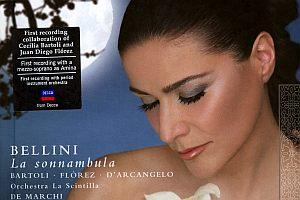Those of us familiar with the opera and its 1831 Hit Parade of Tunes expect to hear a high-flying soprano soar as Amina*. Yet, according to the liner notes for Decca’s new recording of the opera in which mezzo-soprano Cecilia Bartoli sings Amina opposite tenor Juan Diego Flórez’s Elvino and bass Ildebrando D’Arcangelo’s Count Rodolfo, Amina was initially sung by mezzo-sopranos Giuditta Pasta and Maria Malibran. Bartoli’s is thus the first Sonnambula recording to restore the female lead to its mezzo origins.
It is also the first played on period instruments tuned to historically accurate pitch of a = 430 Hz, and the most revelatory since Maria Callas’ commercial and live versions revivified the work in the 1950s**. Bartoli’s Amina is not only the most limpidly sung and technically astounding since Sutherland’s, but also among the most expressive on record. Her fioriture (variations and embellishments) are so cannily worked out, the gradations of volume and tonal shading so exquisite, and the top of her voice so lovely, that you will not likely miss the high E-flats.
Listen to the Music
Flórez is, as expected, a miracle. Perhaps inspired by Bartoli, and/or more free to vary dynamics when not trying to fill the cavernous Metropolitan Opera House, he delivers a far more nuanced portrayal than in his marvelously sung recent live Met HD telecast opposite Dessay. D’Arcangelo sings beautifully, conveying the above-it-all authority of the count who takes the high road rather than playing the lecher, but sacrifices expressivity for speed in his big aria, “Vi ravviso, o luoghi ameni” (O lovely scenes, again I see you). Listen to Boris Christoff’s rendition on YouTube for a telling comparison.
Unbounded praise for the beautiful playing of Orchestra La Scintilla. Alessandro De Marchi lovingly allows his diva all the space and support her creativity requires. Though the repeated wedding bell tinkles become precious, the orchestra’s little woodwind chirps in the intro to “Prendi: l’anel ti dono” are cause for rejoicing. As is the recording itself.
Note: A survey of recordings of Amina’s arias that begins with the acoustic era (Galli-Curci, Tetrazzini, Sembrich, Kurz, and de Hidalgo), extends through the age of early electric ‘78s (dal Monte and Muzio), and culminates in the LP and digital age (Callas, Sutherland, Dessay, Moffo, Swenson, et. al.) reveals that, until Bartoli, only sopranos have recorded the role. Mezzo-soprano Frederica von Stade performed Amina in San Francisco in 1984, but never recorded the opera).
* A survey of recordings of Amina’s arias that begins with the acoustic era (Galli-Curci, Tetrazzini, Sembrich, Kurz, and de Hidalgo), extends through the age of early electrics (dal Monte and Muzio), and culminates in the LP and digital age (Callas, Sutherland, Dessay, Moffo, Swenson, et. al.) indicates that, until Bartoli, only sopranos have recorded the role. (If I’ve missed a mezzo in the discography, someone please let us know). Mezzo-soprano Frederica von Stade sang Amina in San Francisco in 1984, but never recorded the opera.
** You know a recording is special when a huge blow-up of its cover is displayed on the side of Rasputin Records on Telegraph Ave. in Berkeley.

